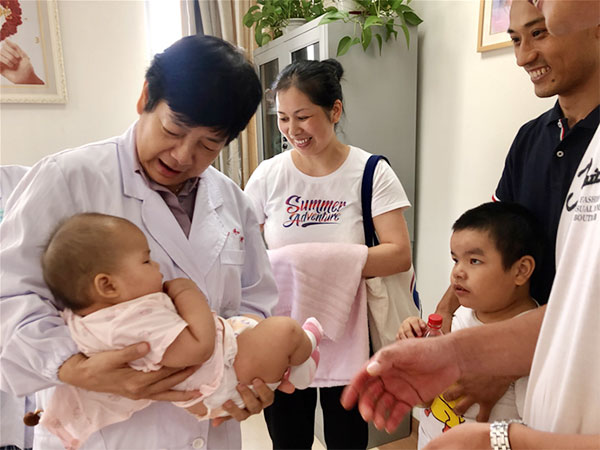
From the People's Daily app.
And this is Story in the Story.
In the past, people with genetic diseases abandoned all hope of starting a family for fear of passing on problematic genes to their child.
However, today, the "third-generation test-tube baby technique" is used to assess and diagnose problems in the genetic makeup of embryos.
The technique ensures that only embryos without disease-causing genes will be moved in the mother's womb to block diseases from being inherited from one generation to the next.
The third-generation test-tube baby technique benefits children suffering from diseases that can be treated with bone-marrow transplants.
The technique has revealed match rates as low as 1 in 100,000 at blood banks, but success rates are as high as 1 in 4 among siblings.
Today’s Story in the Story looks at how doctors are eliminating the risk of hereditary diseases so couples can have healthier babies.

Huang Hefeng, president of the International Peace Maternity and Child Health Hospital of China Welfare Institute in Shanghai, has used the "third-generation test-tube baby technique" since 2001 to help with more than 2,000 healthy births at the hospital. (Photo: China Daily)
Huang Hefeng once joked her job was to help people "make people.” But after 30 years of progress in assisted reproductive technology, she has moved from assisting couples with conceiving children to a role where she purges genes carrying hereditary diseases from family lines.
In the past, most patients with genetic diseases used to abandon all hope of ever starting a family for fear of passing on problematic genes to their child.
"I wouldn't dare to suggest that I'm contributing to the whole nation in preventing birth defects, said Huang, president of the International Peace Maternity and Child Health Hospital of China Welfare Institute in Shanghai.
"Every one of the more than 2,000 children born using the technology at our hospital since its clinical application in 2001 has proven to be as healthy as we diagnosed, without exception," she said
Her medical contributions, including this technology, which is being used in nearly 50 hospitals across 23 Chinese provinces and municipalities, were awarded the top annual honor by the gynecology and obstetrics branch of the Chinese Medical Doctor Association.
A rising number of couples from families carrying genetic tumors are also coming to her for medical help, Huang said.
Couples who have three or more family members or immediate relatives who suffer from a tumor of any kind are medically deemed as a family of high occurrence of tumors.
Since China adopted its second-child policy in 2016, Huang said her patients have included couples with a sick child.
"With the technique, we can pick an embryo whose human leukocyte antigen type matches the couple's first child. When the child is born, the stem cells from his or her umbilical cord blood can be used to treat the brother or sister's disease," she explained.

Huang Hefeng, president of the International Peace Maternity and Child Health Hospital of China Welfare Institute in Shanghai, holds an infant born through test-tube baby technique at the hospital. (Photo: China Daily)
A woman surnamed Yang from Zhejiang Province lost her first child during infancy due to a rare and potentially fatal disease. The mother, a carrier of this disease-causing gene, approached Huang for help and gave birth to a healthy baby last year.
Another of Huang's contributions came in 2013 when she became the first scientist internationally to put forward the theory of "gamete origins of adult disease,” which pushed the boundaries of the widely accepted theory of "development origins of adult disease.”
This theory expounds that the feeding, health, and environment of a fetus can result in certain diseases during adulthood and suggests that the possibility of falling ill in adulthood may be a consequence of changes to the eggs and sperm-even before a new life is formed.
In her study, she saw that the sperm of an obese man before and after losing weight had the same DNA make up, but the epigenetic appearances were completely different.
Huang became an academician with the Chinese Academy of Sciences in 2017, the only doctor from the fields of obstetrics and gynecology elected as an academician after the departure of the late Lin Qiaozhi, one of the founders of modern Chinese gynecology.
"For a doctor, staying abreast of the latest developments in medicine can be a real challenge, but I have learned over the years that technical proficiency is not enough, as you have to offer ethical and economical solutions to each of your patients to achieve an overall balance. This should be the pinnacle that every doctor should aim to reach professionally," she said.
(Produced Nancy Yan Xu, Lance Crayon, Brian Lowe and Elaine Yue Lin. Music by: bensound.com. Text from Global Times and China Daily.)


